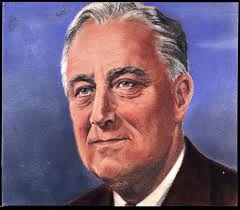In the early 1930s the heads of some of the largest US corporations—’the men who manage America’s industry, trade and finance’—started meeting regularly for dinner in New York. It was during the Great Depression when public confidence in capitalism was at an all time low and Roosevelt was threatening to regulate corporations and curb their power.
One of the diners was Robert B. Henderson, president of Pacific Portland Cement and Vice President of the National Association of Manufacturers (NAM). He described how the dinner meetings had been initiated at a conference where ‘a few advance thinking souls… realized that only top leadership would serve the purposes of business salvation’. He tells how, as a result of these meetings, ‘gradually the gospel spread and the real leadership of American Industry commenced to get into the front line trench’. The group called themselves the ‘Brass Hats’.
The entire project was original. Business men had sold goods and services; they had ‘sold’ individual companies, or industries, or even specific ideas (like the idea that the private ownership of utilities is best); but they had never undertaken to sell business-as-a-whole. Never before had they tried to sell that general philosophy which animates business, and which serves as a guide to social, political, and economic action.
Companies that were supposed to be competitors colluded in a united effort to spread the free market message to the public using every available public relations avenue. To sell ‘business-as-a-whole’ they combined free market ideology, public relations techniques and business networks.
 Franklin D. Roosevelt (pictured) had been elected president of the United States in 1932 with promises of a New Deal between government and the people, a deal that meant that government would intervene to help the people in times of crisis such as the Depression. As part of the New Deal, Roosevelt’s government instituted major legislative and institutional reforms including regulations aimed at stabilising and restoring confidence in the banks; a program of public works projects that gave work to millions of the unemployed and modernised American infrastructure; and measures to reduce poverty.
Franklin D. Roosevelt (pictured) had been elected president of the United States in 1932 with promises of a New Deal between government and the people, a deal that meant that government would intervene to help the people in times of crisis such as the Depression. As part of the New Deal, Roosevelt’s government instituted major legislative and institutional reforms including regulations aimed at stabilising and restoring confidence in the banks; a program of public works projects that gave work to millions of the unemployed and modernised American infrastructure; and measures to reduce poverty.
However these measures involved high levels of government spending, high taxes and increased government intervention in business affairs, all of which were abhorrent to leading business people. The president of the US Chamber of Commerce claimed that the government was in the hands of an ‘organized mob’. Yet the government had so much popular support that business could not attack the New Deal directly without seeming to attack the public; ‘and for business men to attack the public is for them to confess their inability to ‘serve’ the public’.
The answer, business leaders realised, was to change public opinion and undermine the support for New Deal measures. To do this they sought to associate the New Deal with ‘creeping socialism’ and to promote the benefits of unregulated capitalism.
In response to the decline in business confidence that accompanied the Depression and the New Deal programs of the Roosevelt Government many US corporations had already made public relations a permanent part of their management structures. But business leaders realised that a more wholesale, coordinated effort was required if public opinion was to be turned around. They embarked on a full scale battle which Alfred Sloan Jr of General Motors, called ‘a struggle between ‘political management’ [government control] and ‘private enterprise’ [corporate control]’. Sloan urged business leaders to ‘fight to protect the very foundation of the American System’.